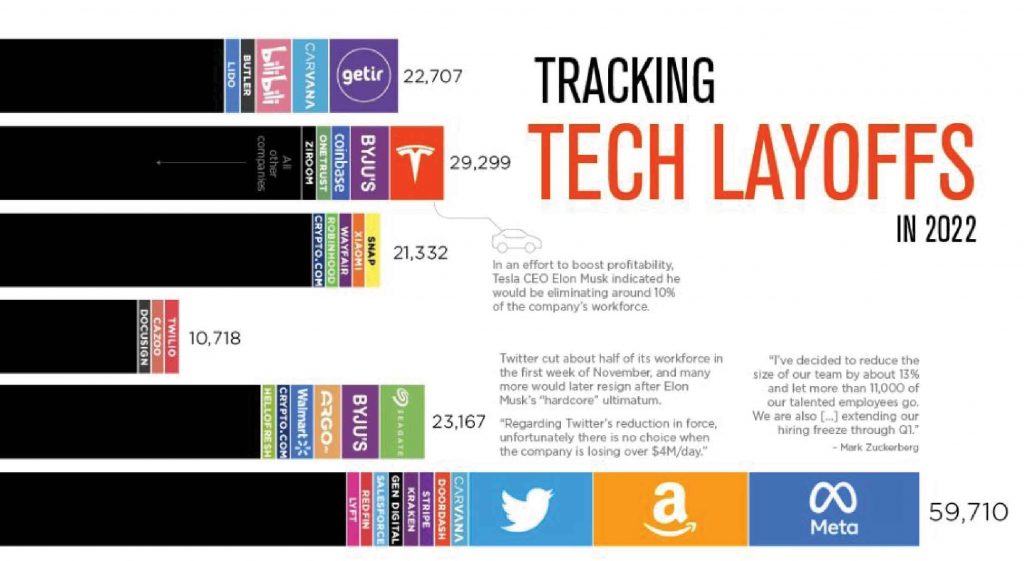Why are US-based tech giants laying off staff globally and will the impacts spill over to other industries?
Can you imagine the wrath of being terminated from your job? It evokes a depressing feeling. Unfortunately millions of employees around the world are facing this sad reality. Many tech giants have been laying off staff from their team. It started with growth companies and now a string of tech giants like Microsoft, Twitter, Meta, Amazon, Spotify, Netflix have started laying off employees worldwide. Recently, Alphabet, a Google parent company, also became an addition to the list of IT giants to opt for job cuts. If we get into the statistics, approximately 150,000 employees from these tech companies were laid off. This lay off continues as Amazon is reported to lay off 10,000 employees. More than 58,000 workers in the U.S.-based tech companies have been laid off in mass job cuts so far in 2023. Now the bigger question is, why are these tech companies laying off so many employees despite massive revenue earning? Well, the answer to this question across tech companies. However, there are some key events that have been causing this widespread downsizing. Let’s have a look at them.
ECONOMIC DOWNTURN
When the U.S. Bureau of Economic Analysis reported a second consecutive quarter of economic contraction in July 2022, discussions of a U.S. recession commenced. Economists are uncertain, and the threat of a downturn persists. Other variables, such as the government debt ceiling, the war in Ukraine, the ongoing pandemic, and the rise in interest rates, threaten the economy’s health. Consequently, companies are resorting to layoffs as a cost-cutting measure anticipating a decline in revenue and profitability.
INFLATION
According to the Federal Reserve, when severe inflation hit the US economy in June 2022, consumers experienced price rises of 9.1%, compared to the usual annual inflation rate of 2%. The US Bureau of Labor Statistics reported the greatest inflation rate in forty years in 2022. (BLS). People began purchasing less due to these increasing prices, which weakened the economy. People and businesses were forced to make sacrifices due to the sharp increase in living expenses. The price of services for technology companies increased, necessitating evaluation and, if necessary, cost reductions. Due to inflation, businesses seek to reduce costs to offset their higher expenses. As one of the most substantial company expenses, employee layoffs are often among the first cost-cutting initiatives. When businesses reduce their advertising budgets, technology companies suffer revenue losses. Tech businesses such as Meta, Google, Instagram, Snap, and ByteDance have ad-based business strategies.
HIGHER INTEREST RATES
In 2022, the US Federal Reserve hiked interest rates seven times and may do so again in 2023. The Fed boosts these interest rates to impede economic development and dissuade people and businesses from spending, reducing demand and lowering prices. Due to rising costs, a company’s desire to borrow is affected by a rise in interest rates. These increased rates directly impact venture capitalists (VC) and other sources of startup investment. Companies will not invest in riskier areas when the economy’s future is uncertain. Economic insecurity prompts businesses to reconsider their recruiting and expansion strategies.
INCREASING PRICE HIKE RATES
The persistent consumer price hike has compelled many central banks to tighten the monetary policy since the beginning of 2022. Almost all central banks started raising key interest rates. The US Federal Reserve was the first to hike rates. Despite the world bank’s caution on rapidly rising interest rates, it is deemed to tame the rising inflation.
DECLINING CONSUMER DEMAND
There has been a significant decline in consumer demand especially in the US. The major cause of it is the high rate of inflation. Price hikes took place in almost all the major economies in the world, such as- US, UK, India, Japan, European Union and others. Despite the world starting to recover from the pressure of the pandemic, the Russia-Ukraine war sparked up disrupting major trade routes. This crisis has preceded an economic downfall which the tech giants are taking into account.
INVESTOR PRESSURE
As a company’s sales decline, investors desire a reduction in expenses. American VCs are increasingly concerned that revenues will decline following this year’s tremendous growth period. For instance, TCI Fund Management urged Alphabet, the parent firm of Google, to reduce personnel and enhance profitability. Other large technology companies, such as Microsoft and Meta, were also criticised by investors for having excessive employees.
EXCESSIVE EMPLOYMENT DURING PANDEMIC
During the pandemic, the COVID-19 restrictions shifted our work process completely online. We conducted our work meetings on Zoom and Google Meets. Streaming platforms like- Netflix, and Amazon Prime took the entertainment industry to newer heights. Hence, this new normal worked well for the giant tech companies as they created record profits. As a result, they hired a greater number of engineers, developers and other tech workers. The situation took a downfall, as the world started recovering from the global COVID-19 pandemic. Although the home-office situation worked well at the time, employees now prefer the hybrid working style. It allows them to closely collaborate, share ideas and build a company culture. Thus, our lives gradually transformed into the post-pandemic culture. The end result? These tech companies hired too many highly experienced software engineers and developers. They earned low to mid six figure incomes. This overstaffing kept continuing.
POST-PANDEMIC SCENARIO
Can you imagine the end result? Well, the tech companies hired too many people. And these aren’t casual admin staff earning $10 an hour, these are highly experienced software engineers and developers earning low to mid six figure incomes. This level of overstaffing for redundancy was necessary at the time, but it’s clear that in many companies, it went too far. Hence, these tech giants started to lay off employees.
IMPACT OF TECH LAYOFF
It is quite obvious that the tech layoff has created a rippling impact on the economy and the tech job market. Tech giants have started conserving cash by trimming down the advertising expense. As these tech companies have reduced recruiting workforce, the junior workforce will be hit the hardest. Nevertheless, the hiring rate has not diminished entirely despite the economic headwinds. Tech job seekers still have shots at smaller companies. As for the investors in tech, the situation varies. Laying off staff does not concern the tech giants to keep the business afloat. Their main agenda is to keep their stakeholders happy. However for startups, a huge layoff may showcase a company’s instability. Thus, tech investment has become extremely challenging. It is hard to tell which companies are laying off as a normal procedure and which ones are facing challenges to their business. However, one aspect is for sure that all companies are executing AI in their system to withstand the risk of recession.
THERE IS NO REASON TO PANIC
There is a prevalent phrase in global finance when America sneezes, the world catches a cold, and it has come true more often than not in the recent past. Therefore, the question of the hour is how it will affect the rest of the world. The rule of thumb usually suggests that if a crisis persists, it will eventually bite the rest of the world. Fortunately, every statistic points to a quick revival of the hiring numbers in the U.S. tech industry. It currently accounts for about 8.9 million people in the total workforce, according to CompTIA’s ( Computing Technology Industry Association) ‘State of the Tech Workforce’ report. Even though there have been several layoffs in the tech and media industries, other labour markets have been steady.
The U.S. unemployment rate fell in December 2022 from 3.7% to 3.5%. Therefore, there have been no signs of the tech layoffs spilling to other sectors of the U.S. economy. According to Professor Barney Tan, Head of the School of Information Systems and Technology Management at UNSW Business School in Australia, we shouldn’t be seeing a downturn in demand for tech workers but more of a realignment in where they go. He adds, “From a longer-term perspective, the fundamentals of the tech sector needing more workers remain sound. This is because we are likely to see the tech talent from these large tech firms move to other areas.
In a world continually being transformed through major technological shifts, being laid off will eventually become part of most people’s lives. Therefore, it is imperative to adapt to the evolving tech scenario. Start investing in skill development relevant to your discipline of work. Many companies are now using the ‘skill-first’ hiring approach on LinkedIn, explicitly using skills data. Gather knowledge of AI, Python, and SQL, as these are the most demanding skills in software. Engage with your professional community regularly as it ushers career guidance, mentorship, and potential job opportunities. As a tech graduate, there are a lot of challenges on your way. However, this challenge gives you a chance to prove your best worth. The best way to adapt to this drastic change is by improving skills. Stay updated with the AI updates. Irrespective of the part of the world, every tech workforce needs to update itself to build performance efficiency continuously.

















